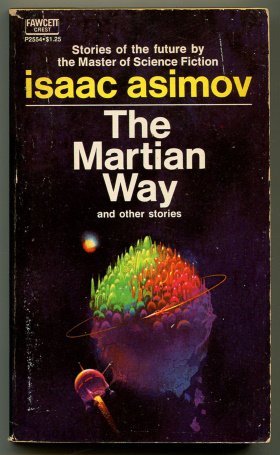‘Look, greasy rocks build tissues, but where does a s1hcony that size get its energy from?’
‘I couldn’t tell you.’
‘Directly from – Have you got anyone around you right now?’
‘Right now, no. I wish there were.’
‘You won’t in a minute. Siliconies get the1r energy by the d1rect absorption of gamma rays.’
‘Says who?’
‘Says a guy called Wendell Urth. He’s a big-shot extraterrologist. What’s more, he says that’s what the silicony’s ears are for.’ Vernadsky put his two forefingers to his temples and wiggled them. ‘.’Not telepathy at all. They detect gamma radiation at levels no human mstrument can detect.’
‘Okay. Now what?’ asked Hawkins. But he was gr wi g thoughtful.
‘Now this. Urth says there isn’t enough gamma radiation on any asteroid to support siliconies more than an inch or two long. No enou ? radioactivity. So here we have one a foot long, a good fifteen mches.
‘Well—’
‘So it has to come from an asteroid just riddled with the stuff, lousy with uranium, solid with gamma rays. An asteroid with enough radioactivity to be warm to the touch and off the regular orbit patterns so that no one’s come across it. Only suppose some smart boy landed on the asteroid by happenstance and noticed the warmth of the_ roc s and got to thinking. This captain of the Robert Q. is no rock-hoppmg ignoramus.
He’s a shrewd guy.’ ‘Go on.’
‘Suppose he blasts off chunks for assay and comes across a giant silicony. Now he knows he’s got the most unbelievable strike in all history. And he doesn’t need assays. The silicony can lead him to the rich veins.’
‘Why should it?’
‘Because it wants to learn about the universe. Because it’s spent a thousand years, maybe, under rock, and it’s just discovered the stars. It can read minds and it could learn to talk. It could make a deal. Listen, the captain would jump at it. Uranium mining is a state monopoly. Unlicensed miners aren’t even allowed to carry counters. It’s a perfect setup for the captain.’
Hawkins said, ‘Maybe you’re right.’
‘No maybe at all. You should have seen them standing around me while I watched the silicony, ready to jump me if I said one funny word. You should have seen them drag me· out after two minutes.’
Hawkins brushed his unshaven chin with his hand and made a mental estimate of the time it would take him to shave. He said, ‘How long can you keep the boy at your station?’
‘Keep him! Space, he’s gone!’
‘What! Then what the devil is all this talk about? Why did you let him get away?’
‘Three guys,’ said Vernadsky patiently, ‘each one bigger than I am, each one armed, and each one ready to kill, I’ll bet. What did you want me to do?’
‘All right, but what do we do now?’
‘Come out and pick them up. That’s simple enough. I was fixing their semireflectors and I fixed them my way. Their power will shut off completely within ten thousand miles. And I installed a tracer in the Jenner manifold.’
Hawkins goggled at Vernadsky’s grinning face. ‘Holy Toledo.’
‘And don’t get anyone else in on this. Just you, me, and the police cruiser. They’ll have no energy and we’ll have a cannon or two. They’ll tell us where the uranium asteroid is. We locate it, then get in touch with Patrol Headquarters. We will deliver unto them, three, count them, three, uranium smugglers, one giant-size silicony like nobody on Earth ever saw, and one, I repeat, one great big fat chunk of uranium ore like nobody on Earth saw, either. And you make a lieutenancy and I get promoted to a permanent Earth-side job. Right?’
Hawkins was dazed. ‘Right,’ he yelled. ‘I’ll be right out there.’
They were almost upon the ship before spotting it visually by the weak glinting of reflected sunlight.
Hawkins said, ‘Didn’t you leave them enough power for ship’s lights?
You didn’t throw off their emergency generator, did you?’
Vernadsky shrugged. ‘They’re saving power, hoping they’ll get picked up. Right now, they’re putting everything they’ve got into a sub-etheric call, I’ll bet.’
‘If they are,’ said Hawkins dryly, ‘I’m not picking it up.’
‘You’re not?’
‘Not a thing.’
The police cruiser spiraled closer. Their quarry, its power off, was drifting through space at a steady ten thousand miles an hour.
The cruiser matched it, speed for speed, and drifted inward.
A sick expression crossed Hawkins’ face. ‘Oh, no!’
‘What’s the matter?’
‘The ship’s been hit. A meteor. Lord knows there are enough of them in the asteroid belt.’
All the verve washed out of Vernadsky’s face and voice. ‘Hit? Are they wrecked?’
‘There’s a hole in it the size of a barn door. Sorry, Vemadsky, but this might not look good.’

























